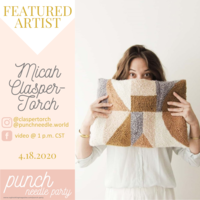The Blue Period
Expanding creativity through monochromatic rugs

Sarah, 15" x 29", #2-cut wool on rug warp. Adapted by a photograph by Ed Flories and hooked by Lois Morris, Rawdon, Quebec, 2000.
Between 1900 and 1904, Pablo Picasso painted mostly in blue and blue-green, sometimes warming his canvases with small doses of creamy yellow and terra cotta. Today the somber Blue Period paintings are some of his most popular works, along with those from his equally somber Rose Period. His practice of painting only in black, white, and gray—called achromatic art—spanned his entire career.
Picasso’s limited color palettes exemplify the idea that restriction fosters creativity. Dr. Seuss wrote the bestseller Green Eggs and Ham by restricting himself to only fifty words. Pachelbel’s glorious Canon in D Major is composed around the repetition of eight chords. That’s how I think about hooking monochromatic rugs: self-imposed limits get us focused, keep us challenged, and pique our curiosity.
But what would we accomplish by hooking a rug that is blue, period? Well, it can sharpen our sense of value and emphasize textural variety. It can endow the rug with an avant-garde or impressionist flavor. And when we’re not consumed with decisions about color, we become free to focus on other aspects of our design.
Depending on how you define the term “monochromatic,” there may be more room for color variation than you think. Here we will explore four color schemes, all of which can be interpreted as monochromes.
This article is from the November/December 2014 issue. For more information on our issues, check out our issues page.








